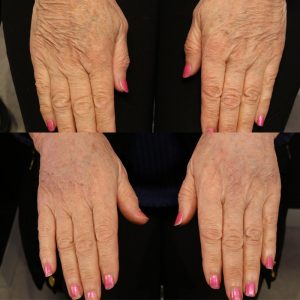Revolumising Hands Treatment Melbourne
It is often said that the face, neck and hands are the areas that reveal your age. We often rejuvenate or treat the face and neck and neglect the hands. The hands can be a ‘give-away’ to your age if not given the proper attention.
This volume loss can be replaced, with several treatments commonly well-known for facial rejuvenation and revolumisation. Like the face, the hands can also show signs of ageing through volume loss and treatments can be used in a similar manner to replace volume loss here. Naturally, fat can be lost in the back of the hands with ageing, leading to problems such as;
- wrinkly skin
- excess show of tendons
- prominent veins
By replacing volume in the back of the hands, the above concerns can be addressed.

All procedures carry a risk of side effects and potential complications. The outcome of each procedure cannot be guaranteed, and individual results may vary. A consultation with one of our practitioners is required prior to any procedure to assess suitability for treatment. Patient consent has been obtained to display images.
Non surgical hand rejuvenation
Volume loss in the hands is a common concern associated with ageing and can contribute to a more prominent appearance of tendons and veins. There are several professional strategies that may be considered to support volume in this area. The suitability of each approach will depend on factors such as individual anatomy, degree of volume loss, and personal preferences, all of which are discussed during a consultation.
Treatments using volumising agents may be discussed to support the restoration of volume in the hands. These formulations may include temporary volume producing products or biostimulatory compounds that encourage the skin’s own collagen production over time. The type and amount of product used is tailored to the patient, and the approach may vary depending on the condition of the skin and the volume loss present.
Surgical hand rejuvenation
Autologous fat transfer involves harvesting a small amount of fat from another area of the body and reinjecting it into the hands. This procedure requires liposuction and is typically performed by surgically trained medical professionals. It is not a service provided at Victorian Cosmetic Institute but may be discussed as an option during your consultation if suitable.
Restoring lost volume in the hands
Restoring volume to the hands is an important consideration in comprehensive hand rejuvenation. It is often performed alongside other treatments, such as laser procedures, which may be used to address concerns like pigmentation or visible age-related changes (including solar lentigos and seborrhoeic keratoses). When facial rejuvenation is undertaken, addressing the hands as well can help achieve a more harmonious and balanced overall appearance.
